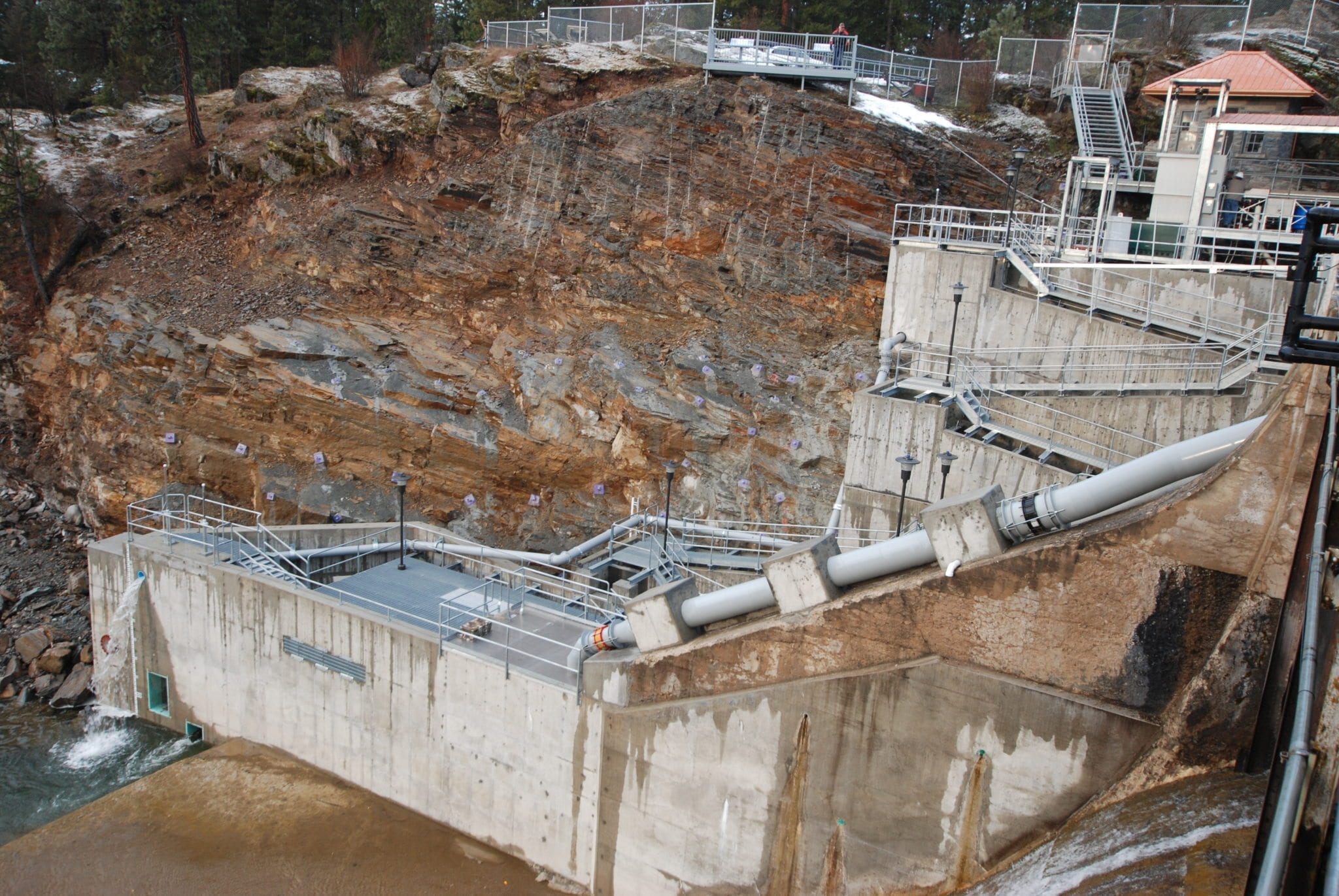Thompson Falls Hydroelectric Project Upstream Passage Fishway

Summary
The two dams that make up the Thompson Falls project have been a barrier to upstream fish migration since it began operation in 1915. In the early 2000’s, biologists confirmed that large numbers of many species of fish were blocked from proceeding as many as 100 miles upstream to their spawning tributaries, highlighting the large geographic impact of the blocked upstream fish migrations.
This fish ladder constructed to overcome this obstacle is precedent-setting as it is the first full-height fish passage ladder in the United States built specifically for the bull trout, a threatened species. The project provides bull trout and other fish species access to hundreds of miles of the upstream Clark Fork River and its tributaries.
Background
The Clark Fork River at Thompson Falls was originally a natural waterfall. In the early 20th century, the energy of this river made this an attractive site to construct a hydroelectric project to power the area’s growing settlements. In 1915, the Thompson Falls Project began operation.
Challenge
Concern grew that blocking upstream adult fish passage could have a profound effect on the reproduction and survival of Clark Fork River fish populations. However, no one had ever designed or built a fish ladder specifically to benefit the bull trout. Attempts to study the bull trout proved difficult and yielded limited successes due to small population sizes. No one really knew how to design a fishway to attract and pass this species. In addition, some fundamental information about migratory behavior of bull trout in the project area was not known and the complex nature of the Thompson Falls Project site raised questions about fishway location.
The project’s listing on the National Register of Historic Places presented another challenge as constructing a fishway would modify the historic character of the site.
Innovation
PPL Montana established an interagency, multi-disciplinary Technical Advisory Committee (TAC) to work collaboratively to find solutions to these questions. The TAC included members from PPL Montana, Montana Fish, Wildlife and Parks, the U.S. Fish and Wildlife Service, the Confederated Salish and Kootenai Tribes, Avista Corporation, Northwestern Energy, and a consultant team to provide technical support.
In October 2006 the TAC made a unanimous decision to pursue a full height fish ladder at the right bank of the Main Dam Spillway. Design work began in 2007, and ladder construction was begun in 2009 and completed in 2010. The ladder — which replaced an experimental, small-scale temporary fish passage system used since 2003 —has 47 individual concrete step pools that permits fish to gradually ascend about 75 feet to the top of, and over, the dam.
The ladder is designed for maximum operational flexibility, so that hydraulic conditions can be modified to accommodate the preferences of the bull trout. The panels that separate individual pools of the ladder can be adjusted so that they operate as either weirs or orifices. Operators can make this adjustment without dewatering the ladder, so that it is convenient to test which configuration is preferred by bull trout.
Attraction flow is adjustable as well. The ladder can operate with as little as 6 cfs. However, auxiliary water can be added to add to the attraction flow if needed to assist fish to find the facility. A high velocity jet, which releases water from the ladder into the tailrace to attract fish, can be used whenever conditions require it.
A sampling loop was built into the upstream end of the ladder to allow biologists to monitor the fish using the ladder. The ladder can be configured to allow fish volitional passage into the reservoir upstream, or fish can be routed into the sample loop for data collection and tagging.
Areas downstream of the Project site contain several species of non-native fish which are considered by local fisheries managers to be undesirable. A fish return pipe has been provided which allows biologists to sort these fish and return them to the tailrace, without allowing upstream fish passage.
Results
The Thompson Falls Fish Ladder now provides upstream access to hundreds of miles of main stem river Clark Fork River habitat, plus tributaries known to be bull trout spawning streams, that wereinaccessible to fish since 1915. Many of these river miles are designated as “critical habitat” for bull trout by the U.S. Fish and Wildlife Service. Over time, providing upstream adult fish passage at Thompson Falls Dam will result in more bull trout successfully returning to their natal streams to spawn. In addition, other game fish and native non-game fish will also be able to complete migrations and spawn in their preferred habitats, enhancing the health of the entire Clark Fork River aquatic ecosystem.
The ladder was fully operational on March 16, 2011. The first fish, a rainbow trout, was collected at the sampling facility on March 21, 2011. The first bull trout ascended the ladder and was released upstream on April 13, 2011.
High spring flows in the Clark Fork River necessitated a shutdown of the ladder on May 24, 2011. Unusually high flows in 2011 resulted in damage to the Main Dam Spillway. Repairs to the spillway required that the reservoir be drawn down to crest, which delayed the time when the ladder could be placed back in operation. The ladder was re-opened on August 22, 2011. Large numbers of trout and other native fishes were collected during August and September. The total catch at the ladder during 2011 was 1,723 fish, of 11 species, including two bull trout. This was a very positive result as the ladder was not expected to pass such a large number and diversity of fish species, nor the wide range of fish sizes.
Stakeholder Quote
“On behalf of myself, tribal people and our ancestors, I thank you. It’s good to see people looking back and repairing some of the damages done in the past.” Tony Incashola, director of the Salish-Pend d’Oreille Tribal Cultural Committee.


